王蔷《英语教学法教程》笔记
王蔷《英语教学法教程》笔记和课后习题(含考研真题)详解(交际教学原则与任务型语言教学)【圣才出品】
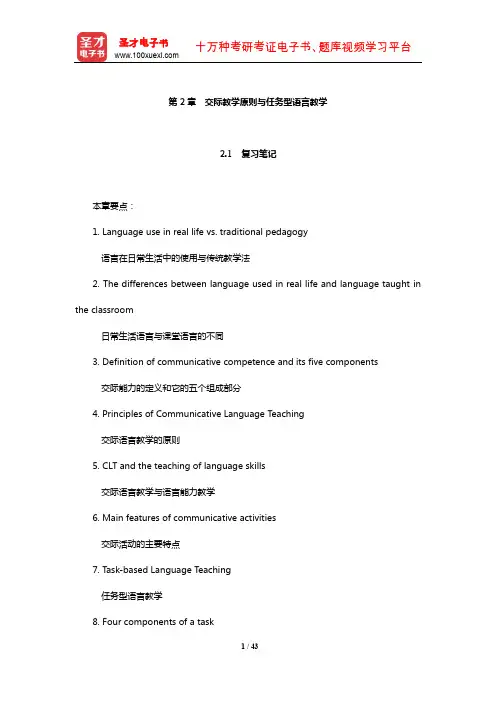
第2章交际教学原则与任务型语言教学2.1 复习笔记本章要点:1. Language use in real life vs. traditional pedagogy语言在日常生活中的使用与传统教学法2. The differences between language used in real life and language taught in the classroom日常生活语言与课堂语言的不同3. Definition of communicative competence and its five components交际能力的定义和它的五个组成部分4. Principles of Communicative Language Teaching交际语言教学的原则5. CLT and the teaching of language skills交际语言教学与语言能力教学6. Main features of communicative activities交际活动的主要特点7. T ask-based Language Teaching任务型语言教学8. Four components of a task任务的四个部分9. PPP and T ask-based Language Teaching介绍,练习和产出与任务型语言教学10. The steps to design tasks设计任务的步骤11. Appropriateness of CLT and TBLT in the Chinese context交际语言教学的恰当性和中文环境的任务型语言教学本章考点:语言在日常生活中的使用与传统教学法;日常生活语言与课堂语言的不同;交际能力的定义和它的五个组成部分;交际语言教学的原则;交际语言教学与语言能力教学;交际活动的主要特点;任务型语言教学;任务的四个部分;介绍,练习和产出与任务型语言教学的不同;设计任务的步骤;交际语言教学的恰当性和中文环境的任务型语言教学。
王蔷《英语教学法教程》笔记和课后习题(含考研真题)详解(英语教育资源的开发与利用)【圣才出品】
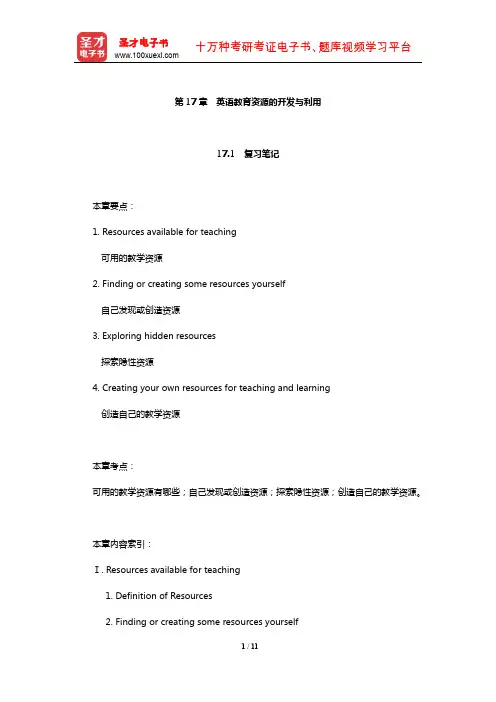
第17章英语教育资源的开发与利用17.1 复习笔记本章要点:1. Resources available for teaching可用的教学资源2. Finding or creating some resources yourself自己发现或创造资源3. Exploring hidden resources探索隐性资源4. Creating your own resources for teaching and learning创造自己的教学资源本章考点:可用的教学资源有哪些;自己发现或创造资源;探索隐性资源;创造自己的教学资源。
本章内容索引:Ⅰ. Resources available for teaching1. Definition of Resources2. Finding or creating some resources yourselfⅡ. Exploring hidden resourcesⅢ. ConclusionⅠ.Rsources available for teaching(可用的教学资源)1. Definition of Resources(教学资源的定义)It refers to books, any person, animals, or any object, that make teaching and learning easier, clearer and more interesting. Obviously, in teaching English, we will need different kinds of resources to make our teaching more effective. Some publishers nowadays provide teachers with a package of materials which include flashcards, pictures, storybooks, tapes or CD-ROMs.教学资源主要包括课本、人、动物以及任何让教学更简单、更清晰、更有趣的物体。
王蔷《英语教学法教程》笔记和课后习题(含考研真题)详解(综合技能)【圣才出品】
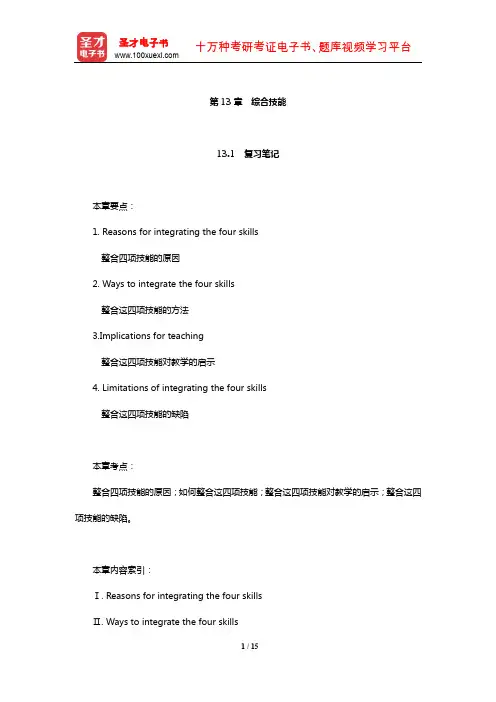
第13章综合技能13.1 复习笔记本章要点:1. Reasons for integrating the four skills整合四项技能的原因2. Ways to integrate the four skills整合这四项技能的方法3.Implications for teaching整合这四项技能对教学的启示4. Limitations of integrating the four skills整合这四项技能的缺陷本章考点:整合四项技能的原因;如何整合这四项技能;整合这四项技能对教学的启示;整合这四项技能的缺陷。
本章内容索引:Ⅰ. Reasons for integrating the four skillsⅡ. Ways to integrate the four skillsⅢ. Implications for teaching1. Focus on discourse2. Adjusting the textbook contents3. Adjusting the timetableⅣ. Limitations of integrating the four skillsⅤ. ConclusionⅠ. Reasons for integrating the four skills|(整合四项技能的原因)【考点:整合四项技能的原因】In our daily lives, we are constantly performing tasks that involve a natural integration of language skills simply because skills are rarely used in isolation. One’s overall competence in a foreign language involves performing effectively a combination of the skills.我们在现实生活中完成的任务需要综合四项技能。
王蔷《英语教学法教程》笔记和课后习题(含考研真题)详解(口语教学)【圣才出品】

第10章口语教学10.1 复习笔记本章要点:1. Characteristics of spoken language口语的特点2. Four common features of spoken language口语的四个共同特征3. Activities help prepare students for real-life speech in English 为学生做好日常口语准备的活动4. General principles of teaching speaking口语教学的普遍原则5. Two factors considered in designing speaking tasks设计口语任务要考虑的两个因素6. Common characteristics in successful speaking task成功的口语任务的共性7. Two types of communicative speaking activities两种不同类型的交际口语活动8. Some kinds of speaking activities几种不同类型的口语活动9. Advantages of using group in speaking tasks使用分组教学的优势本章考点:口语的特点及对教学的暗示;口语的四个共同特征;为学生做好日常口语准备的活动;口语教学的普遍原则;设计口语任务要考虑的两个因素;成功的口语任务的共性;两种不同类型的交际口语活动;几种不同类型的口语活动;使用分组教学的优势。
本章内容索引:Ⅰ. Differences between spoken and written language1. Characteristics of spoken language2. Four common features of spoken language3. Activities helpful to prepare students for real-life speech in English4. Some implications to teachingⅡ. Principles for teaching speakingⅢ. Designing speaking tasks1. Two factors considered in designing speaking tasks2. Common characteristics in successful speaking tasksⅣ.Types of speaking tasks1. Two major purposes for listening2. Two types of communicative speaking activities3. Some kinds of speaking activities4. Other speaking activitiesⅤ.Organizing speaking tasksⅥ.ConclusionⅠ.Differences between spoken and written language (口语与书面语的区别)【考点:口语的特点及对教学的暗示】Speaking is a skill that the students will be judged upon most in real-life situations.口语是用来判断学生在实际生活中使用最多的技能。
王蔷《英语教学法教程》笔记和课后习题(含考研真题)详解-第11~13章【圣才出品】
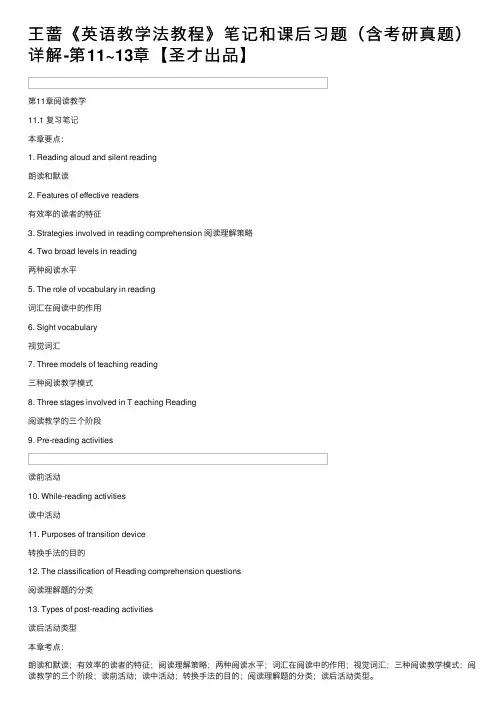
王蔷《英语教学法教程》笔记和课后习题(含考研真题)详解-第11~13章【圣才出品】第11章阅读教学11.1 复习笔记本章要点:1. Reading aloud and silent reading朗读和默读2. Features of effective readers有效率的读者的特征3. Strategies involved in reading comprehension 阅读理解策略4. Two broad levels in reading两种阅读⽔平5. The role of vocabulary in reading词汇在阅读中的作⽤6. Sight vocabulary视觉词汇7. Three models of teaching reading三种阅读教学模式8. Three stages involved in T eaching Reading阅读教学的三个阶段9. Pre-reading activities读前活动10. While-reading activities读中活动11. Purposes of transition device转换⼿法的⽬的12. The classification of Reading comprehension questions阅读理解题的分类13. Types of post-reading activities读后活动类型本章考点:朗读和默读;有效率的读者的特征;阅读理解策略;两种阅读⽔平;词汇在阅读中的作⽤;视觉词汇;三种阅读教学模式;阅读教学的三个阶段;读前活动;读中活动;转换⼿法的⽬的;阅读理解题的分类;读后活动类型。
本章内容索引:Ⅰ. Reflecting on your own reading experiencesⅡ. The way of reading1. Reading aloud and silent reading2. Features of effective readersⅢ. The content of readingⅣ. Strategies involved in reading comprehension1. Definition of reading2. Two broad levels in readingⅤ. The role of vocabulary in reading1. The importance of vocabulary2. Sight vocabularyⅥ. Principles and models for teaching reading1. Three models of teaching reading2. Three stages involved in teaching reading Ⅶ. Pre-reading activities1. Definition of pre-reading activities2. Predicting3. Setting the scene4. Skimming5. Scanning6. Summary on pre-reading activitiesⅧ. Whi le-reading activities1. Information transfer2. Purposes of transition device3. Reading comprehension questions4. Understanding references5. Making inferences6. Summary on while-reading activitiesⅨ. Post-reading activities1. Objectives2. Requirements3. Types of post-reading activitiesⅩ. ConclusionⅠ. Reflecting on your own reading experiences (反思⾃⼰的阅读经验)All of us began reading in our first language at a very early age and we all have experiences of being influenced by certain authors or particular books.我们在很⼩的时候开始⽤母语阅读了,我们都受到某些作者或书籍的影响。
王蔷《英语教学法教程》笔记和课后习题(含考研真题)详解(语音教学)【圣才出品】
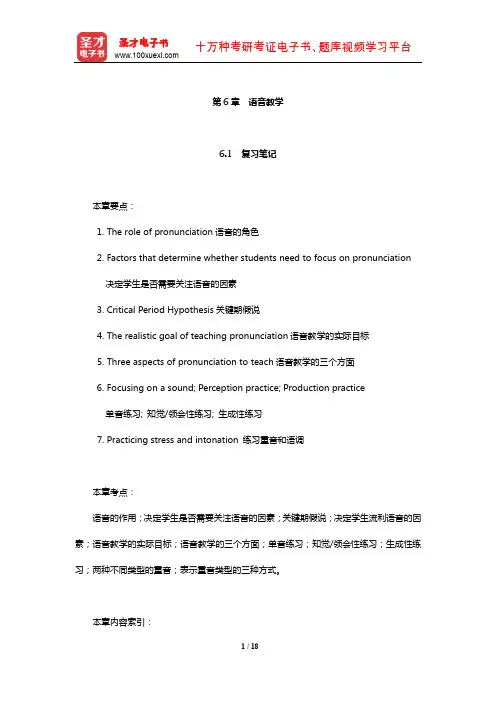
第6章语音教学6.1 复习笔记本章要点:1. The role of pronunciation语音的角色2. Factors that determine whether students need to focus on pronunciation决定学生是否需要关注语音的因素3. Critical Period Hypothesis关键期假说4. The realistic goal of teaching pronunciation语音教学的实际目标5. Three aspects of pronunciation to teach语音教学的三个方面6. Focusing on a sound; Perception practice; Production practice单音练习; 知觉/领会性练习; 生成性练习7. Practicing stress and intonation 练习重音和语调本章考点:语音的作用;决定学生是否需要关注语音的因素;关键期假说;决定学生流利语音的因素;语音教学的实际目标;语音教学的三个方面;单音练习;知觉/领会性练习;生成性练习;两种不同类型的重音;表示重音类型的三种方式。
本章内容索引:Ⅰ. The role of pronunciationⅡ. The goal of teaching pronunciation1. Critical Period Hypothesis2. Factors that determine if the students can aquire native-like English pronunciation3. The realistic goal of teaching pronunciationⅢ. Aspects of pronunciation1. Three aspects of pronunciation to teach2. One common problem in learning pronunciationⅣ. Practicing sounds1. Focusing on a sound2. Perception practice3. Production practiceⅤ. Practicing stress and intonation1. Practicing stress2. Practicing intonationⅥ. ConclusionⅠ. The role of pronunciation(语音的作用)【考点:语音的作用;决定学生是否需要关注语音的因素】Whether pronunciation needs special attention or focus in language teaching depends on many factors, especially learner factors.语言教学中是否需要特别关注语音取决于许多因素,尤其是学习者因素。
王蔷《英语教学法教程》笔记和课后习题(含考研真题)详解(词汇教学)【圣才出品】
第8章词汇教学8.1 复习笔记本章要点:1. The role of vocabulary uncertainty词汇的不确定性因素2. About knowing a word学习词汇应该包含的内容3. Understanding of its denotative and connotative meaning; 理解其外延意义和内涵意义4. Understanding the sense relations among words理解词汇间的语义关系5. Receptive and productive vocabulary接受性词汇和产出性词汇6. Ways of presenting vocabulary讲授词汇的方法7. Things a teacher does after presentation教师讲完词汇后应该做什么8. Ways of consolidating vocabulary巩固词汇的方法9. Developing vocabulary learning strategies发展词汇学习策略本章考点:理解词汇和词汇学习;词汇的不确定性因素;学习词汇应该包含的内容;词汇的学习;接受性词汇和产出性词汇;讲授词汇的方法;教师讲完词汇后应该做什么;巩固词汇的方法;词汇学习的策略。
本章内容索引:Ⅰ. Understanding vocabulary and vocabulary learningⅡ. About knowing a word1. Knowing a word2. Vocabulary learningⅢ. Ways of presenting vocabulary1. The methods to present and explain vocabulary2. Things a teacher does after presentationⅣ. Ways of consolidating vocabularyⅤ. Developing vocabulary learning strategies1. Review regularly2. Guess meaning from context3. Organize vocabulary effectively4. Use a dictionary5. Manage strategy useⅥ. ConclusionⅠ. Understanding vocabulary and vocabulary learning (理解词汇和词汇学习)【考点:理解词汇和词汇学习;词汇的不确定性因素】The role of vocabulary seems to have received more consistent understanding.大家对词汇的角色的认识基本上是一致的。
王蔷《英语教学法教程》笔记和课后习题(含考研真题)详解-第7~10章【圣才出品】
第7章语法教学7.1 复习笔记本章要点:1. The role of grammar in language learning语法在语言教学中的角色2. Grammar presentation: the deductive method; the inductive method; the guided discovery method 演示法:演绎法,归纳法和引导发现法3. Distinction between implicit and explicit knowledge隐性知识与显性知识的差异4. New approaches to teaching grammar新的语法教学5. Grammar practice: Mechanical practice; Meaningful practice; Using prompts for practice语法练习:机械性练习;意义性练习;使用提示本章考点:语法在语言教学中的角色;演示法:演绎法,归纳法和引导发现法及它们的优缺点;隐性知识与显性知识的差异;新的语法教学;语法练习:机械性练习;意义性练习;使用提示。
本章内容索引:Ⅰ. The role of grammar in language learningⅡ. Grammar presentation1. The deductive method2. The inductive method3. The guided discovery method4. Distinction between implicit and explicit knowledge5. New approaches to teaching grammarⅢ. Grammar practice1. Mechanical practice2. Meaningful practice3. Using prompts for practiceⅣ. ConclusionⅠ. The role of grammar in language learning(语法在语言教学中的角色)【考点:语法在语言教学中的角色】Despite many different views about the role of grammar in language learning, the importance of grammar cannot be denied. Grammatical competence is essential for communication.人们对语法在外语教学中的价值众说纷纭,意见不一,尽管如此,语法的重要性是不言而喻的。
王蔷《英语教学法教程》笔记和课后习题(含考研真题)详解-第1~3章【圣才出品】
第1章语言和语言学习1.1 复习笔记本章要点:1. The way we learn languages我们习得语言的方式2. Views on language语言观点3. The structural view of language结构主义语言理论4. The functional view of language功能主义语言理论5. The interactional view of language交互语言理论6. Common views on language learning关于语言学习的普遍观点7. Process-oriented theories and condition-oriented theories 强调过程的语言学习理论和强调条件的语言学习理论8. The behaviorist theory行为主义学习理论9. Cognitive theory认知学习理论10. Constructivist theory建构主义学习理论11. Socio-constructivist theory社会建构主义理论12. Qualities of a good language teacher一个好的语言老师必备的素养13. Teacher’s professional development教师专业技能发展本章考点:我们如何习得语言;结构主义语言理论;功能主义语言理论;交互语言理论;关于语言学习的普遍观点;强调过程的语言学习理论和强调条件的语言学习理论;行为主义学习理论;认知学习理论;建构主义学习理论;社会建构主义理论;成为一个好的语言老师所要具备的基本素质;教师专业技能发展图。
本章内容索引:Ⅰ. The way we learn languagesⅡ. Views on language1. The structural view of language2. The functional view of language3. The interactional view of languageⅢ. Views on language learning and learning in general1. Research on language learning2. Common views on language learning and learning in general(1)Behaviorist theory(2)Cognitive theory(3)Constructivist theory(4)Socio-constructivist theoryⅣ. Qualities of a good language teacherⅤ. Development of a good language teacherⅥ. An overview of the bookThis chapter serves as an introduction for setting the scene for this methodology course. It discusses issues concerning views on language and language learning or learning in general with the belief that such views will affect teachers’ ways of teaching and thus learners’ ways of learning. The qualities of a good language teacher are also discussed in order to raise the participants’ awareness of what is required for a good English teacher.这一章主要是介绍教学法的方法论,其中讨论的问题涉及语言和语言学习的观点,或者一般学习及这些观点对教师教学方式和学习者学习方式的影响,本章也讨论了一个好的英语教师应具备的素质,以提高语言教学参与者对优秀英语教师相关要求的意识。
王蔷《英语教学法教程》笔记和课后习题(含考研真题)详解(学习者个体差异与学习策略培养)【圣才】
王蔷《英语教学法教程》笔记和课后习题(含考研真题)详解(学习者个体差异与学习策略培养)【圣才】第16章学习者个体差异与学习策略培养16.1 复习笔记本章要点:1. Understanding learner differences了解学习者的个体差异2. Eight different types of learners⼋种不同类型的学习者3. Multiple intelligence多元智能4. Learner training in language teaching语⾔教学中学习策略的培养5. Three areas for preparing learners to become autonomous 从三个⽅⾯让学习者成为⾃主学习者6. Two stages for learner training学习策略培养的两个阶段7. Some ideas adapted in learner training培养学习策略的⽅法本章考点:了解学习者的个体差异;⼋种不同类型的学习者;多元智能;语⾔教学中学习策略的培养;从三个⽅⾯让学习者成为⾃主学习者;学习策略培养的两个阶段;培养学习策略的⽅法。
本章内容索引:Ⅰ. Understanding learner differences1. Eight different types of learners2. Multiple intelligenceⅡ. Learner training in language teaching1. An understanding of learner training2. Three areas for preparing learners to become autonomous3. Two stages for learner training4. Some ideas adapted in learner trainingⅢ. ConclusionⅠ. Understanding learner differences(了解学习者的个体差异)【考点:学习者的个体差异;⼋种不同类型的学习者;多元智能】People learn in different ways. Some people learn better from seeing things and using diagrams while other people enjoy reading and writing more than seeing movies or watching television. Different people have different learning styles.⼈们的学习⽅式不同,⼀些⼈通过观察事物和图表获得更好的学习体验,⽽其他⼈⽐起看电影或电视则更喜欢阅读、写作。
